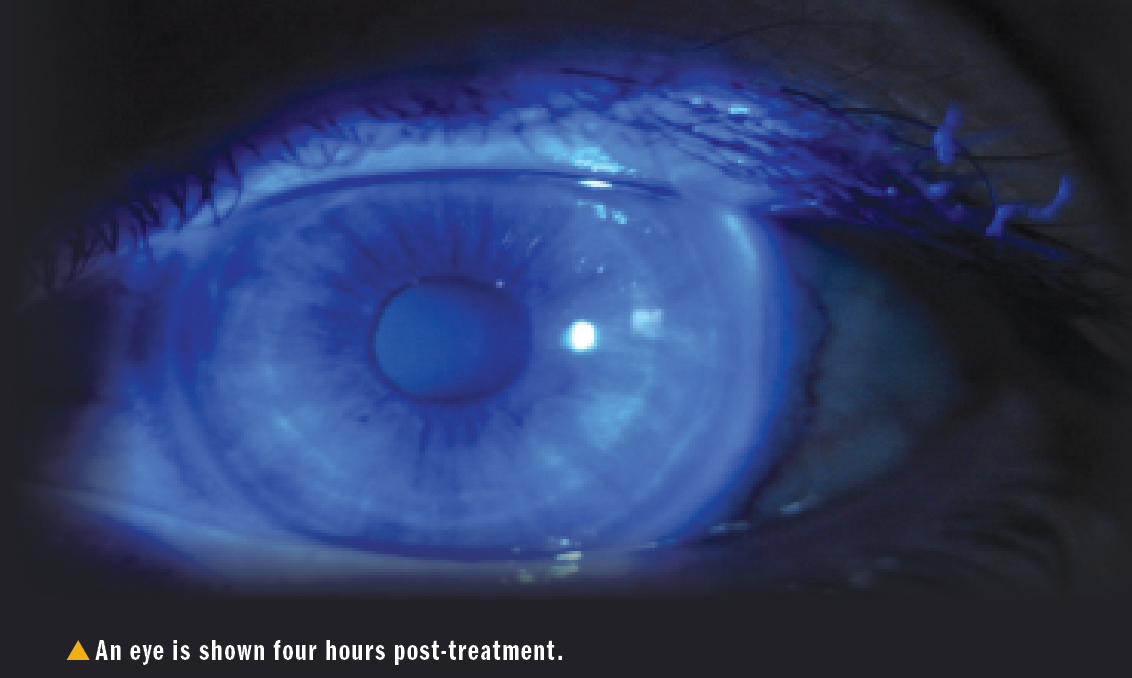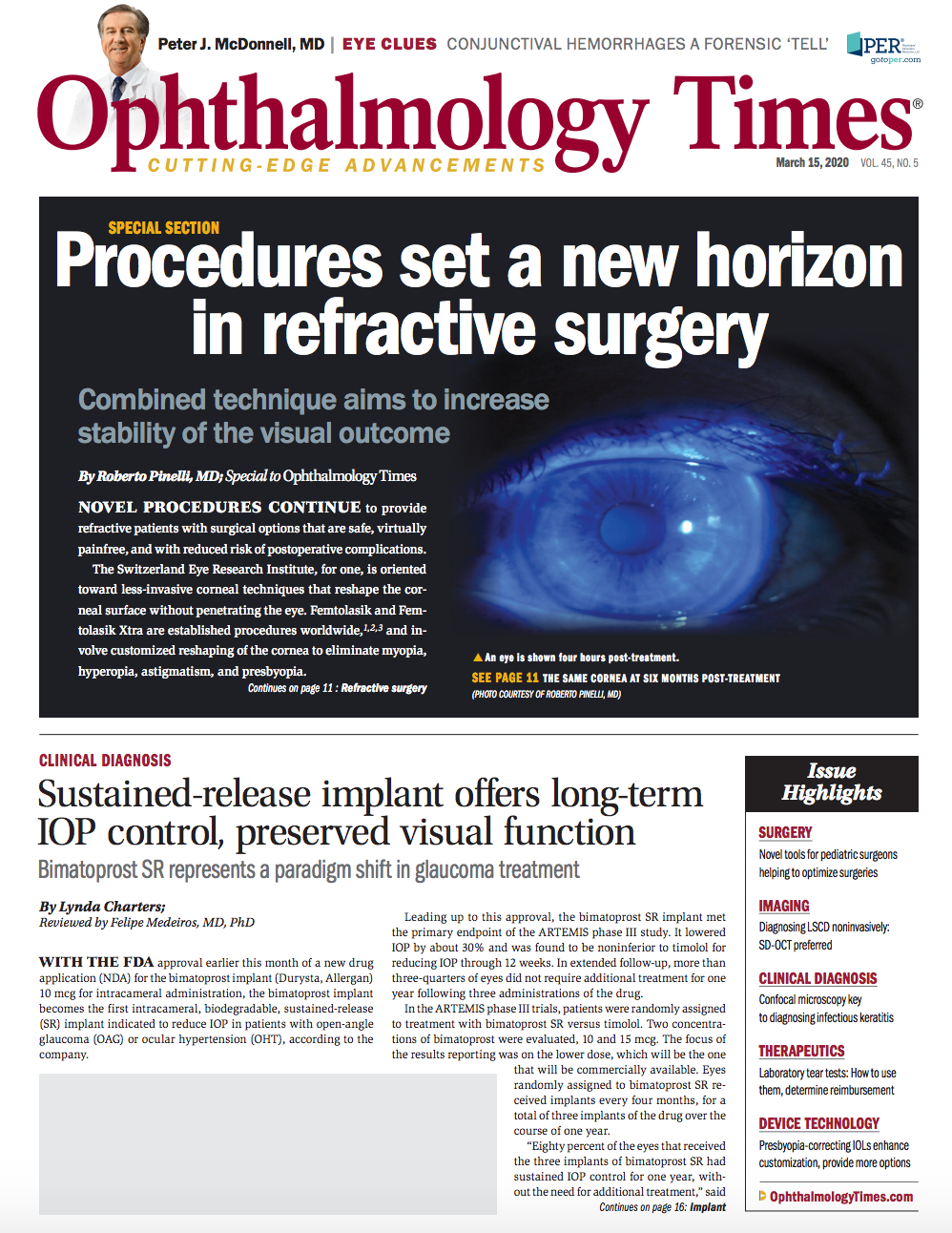Publication
Article
Digital Edition
Procedures set a new horizon in refractive surgery
Author(s):

Special to Ophthalmology Times®
Novel procedures continue to provide refractive patients with surgical options that are safe, virtually painfree, and with reduced risk of postoperative complications.
The Switzerland Eye Research Institute, for one, is oriented toward less-invasive corneal techniques that reshape the corneal surface without penetrating the eye. Femtolasik and Femtolasik Xtra are established procedures worldwide,1,2,3 and involve customized reshaping of the cornea to eliminate myopia, hyperopia, astigmatism, and presbyopia.
Related: Exploring ins, outs of better imaging for LASIK, refractive surgery
Over the past six years, we have been approaching corneal surgery in Lugano using a novel procedure that unites Femtolasik and transepithelial crosslinking.
This combined technique is known as Femtolasik Lux, and aims to increase the stability of the visual outcome in patients, thereby maintaining a healthy and robust cornea.
Femtolasik Lux is a non-invasive, “no-touch” procedure, which-at no point touching the eye with any instrument-uses three different light sources to resolve any visual defect in a few minutes without pain.
This procedure leads to a final sharp refractive result, provides a stronger corneal tissue that is less vulnerable to curvature change, and reduces refractive error regression and incidence of corneal ectasia.
Safety, effectiveness, and excellent long-term results have been demonstrably achieved.
There is a protocol for this technique called the Lugano Protocol. ParaCel eye drops are used to soak the corneal epithelium for a time that cn range from 30 to 50 seconds after the repositioning of the flap.
Related: CXL-LASIK pairing can enhance refractive outcomes
Soaking is thus customized and a very minimal quantity of riboflavin is delivered to the cornea in a short time, which is possible due to its osmotic properties.4
Exposure to UV-A is performed with Avedro technology at 30 mW/cm2. This quantity of ParaCel and timing of exposure are enough to permit ParaCel to penetrate the flap and spread into the stroma.
Unlike other data reported in the current literature, we osmotically soak the cornea over the flap leaving the interface free from any possible irregularity due to riboflavin on the cornea.
Related: Facing challenge of corneal infection management in operated eyes
The purpose is to take advantage of CXL treatment, usually performed to strengthen corneal tissue, in order to stiffen a prospective weakened cornea and prevent corneal ectasia, which is every refractive surgeon’s nightmare.
Though the chances of ecstasia occurring have become very much reduced over the past decade, it nonetheless remains a remote possibility to be avoided. I am pleased to report that after our six years with this procedure, we have not experienced one case of ectasia.
As far as side effects are concerned, I believe that there are no adverse events to report and no flap wrinkles. (Figure 1)

It seems that the riboflavin penetration did not induce any refractive change. On the contrary, a greater stability and a better and softer crosslinking of the cornea were observed, and less regression, particularly regarding myopic astigmatism.
Related: Traversing the CXL pathway: Where do we go from here?
With ParaCel being osmotic, its penetration through the cap to the corneal stroma probably restores biomechanical strength to the cornea.
This aspect enables the flap to become better reintegrated into the cornea, becoming one with the other corneal layers, and thereby more stable and less susceptible to dislodging, unlike the situation in the past. I believe that this is why we don’t see any ectasia.
In addition to the assessment of postoperative visual data, the self-perceived satisfaction with the procedure was evaluated by our Psychology of Vision Unit: objective/subjective outcomes were found to be equally positive.
Researchers said their experience with Femtolasik Lux with the Lugano Protocol has also been positive, and they fully intend to continue with this technique in order to restore vision and improve the overall quality of life in our patients
Miorica Bertelli, OD, Caterina Berti, OD, and Elena Scaffidi, MS, contributed to this report.Read more refractive surgery content
Robert Pinelli, MD
E: pinelli@seri-lugano.ch
Dr. Pinelli is founder of the Switzerland Eye Research Institute.
References:
1. Aslanides IM, Mukherjee AN. Adjuvant corneal crosslinking to prevent hyperopic LASIK regression. Clin Ophthalmol. 2013;7:637-641.
2. Wu Y, Tian L, Wang LQ, Huang YF. Efficacy and Safety of LASIK Combined with Accelerated Corneal Collagen Cross-Linking for Myopia: Six-Month Study. Biomed Res Int. 2016;2016: Article number: 5083069.
3. Rajpal RK, Wisecarver CB, Williams D, Rajpal SD, Kerzner R, Nianiaris N, Lytle G, Hoang K. Lasik Xtra Provides Corneal Stability and Improved Outcomes. Ophthalmol Ther. 2015;4:89-102.
4. Raiskup F, Pinelli R, Spoerl E. Riboflavin osmolar modification for transepithelial corneal cross-linking. Curr Eye Res. 2012;37:234-238.
Newsletter
Don’t miss out—get Ophthalmology Times updates on the latest clinical advancements and expert interviews, straight to your inbox.





